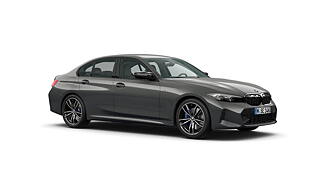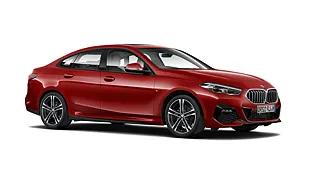Why would I buy it?
- Easy to drive
- Roomy cabin
- Powertrain options
Why would I avoid it?
- Poor plastic quality in places
- Non-reclining rear seats
- Underwhelming driving experience
What is it?
Is the cabin of the X3 any good?
7.5 / 10

Inside, there's a familiar feel to the X3's cabin. The curved TFT display that doubles up as the driver information screen and the central touchscreen for the multimedia system is something we have already seen on the new 7 and 5 Series. The display is crisp; the touch is responsive; and the central screen is nice to look at, and interact with. The curved display also gives the X3's cabin a premium air. The new X3 also employs hidden aircon vents like its sedan siblings as part of the interaction bar. But, unlike the sedans, the X3's interaction bar and ambient lighting don’t span the dashboard, leaving the dash feeling somewhat bulky.

The central console design is different with a near-vertically stacked wireless charging pad and deep-set cup holders. However, the design for the gear selector, the iDrive controls including the shortcut keys, and the buttons and rollers for My Mode and volume control are similar to the 5.
The steering is new too, and it now uses a two-spoke design and it isn't exactly round. BMW, quite unimaginatively, calls it a polygonal rim. The feel of quality and operability across the cabin is what you'd expect in a premium SUV - well-engineered, solid, and user-friendly. Furthermore, to do its bit for the environment, BMW has opted for recycled materials for its seats and dashboard instead of leather. This could be an issue for some because the recycled materials don't bring the same air of opulence as leather and metal finishes to the cabin. What makes things even more challenging for the new X3 is the use of cheap-looking black plastic on the door pads and parts of the dashboard.
The features list on the new X3 meanwhile is acceptable, if not outstanding. The curved screen and the interaction bar remain the highlights. But, it also gets electrically powered front seats with memory, three-zone climate control, automatic tailgate, and LED lighting with welcome and goodbye animations as standard.

BMW has also introduced a panoramic fixed glass roof, sun blinds for the rear passenger, a head-up display, a high-end sound system, adaptive lighting, and seat cooling, but all as optional extras. We hope that for the Indian market, many of these options will be offered as standard to up the new X3's 'want' coefficient.

As far as seating goes, the new X3 has grown in length and width. But, its wheelbase is mostly unchanged. This is not a problem though, because the rear knee room - even for a six-footer - is adequate. There's decent headroom as well even with the glass roof in place. And the X3 was never short of shoulder room; so seating three abreast at the rear in the new car remains a non-issue. The seats all around are large and comfy, especially at the front. The X3 offers a great balance between an involving driving position and comfortable seating for the driver. At the rear, the seat back does not recline, but it holds you well in place. The seat bottom though is a little short and too close to the ground affecting thigh support for the worse.

The boot has grown in size and is one of the more spacious ones in its class in terms of luggage volume; it offers 570 litres of volume. Plus, the rear seats split and fold adding flexibility. Furthermore, the wide and tall boot opening makes it easy to pack luggage of various shapes and sizes.
Is the X3 good to drive?
8 / 10

Currently, the X3 is only offered as the 20d with a four-cylinder, 2-litre diesel in India. The 2-litre petrol under the 30i guise was discontinued sometime back. The 30i will not come back with the new X3 in India. Instead, we will get the 2-litre petrol as the 20 (BMW has dropped the 'i' for its petrol-powered cars and has left it exclusively for electrics), while the diesel 20d will continue.

The X3 20d remains a 2-litre diesel. It gets a 48V mild hybrid system now which pushes its max power and torque ratings to 197bhp and 400Nm. The petrol too gets the 48V system, and it makes 206bhp and 320Nm of peak torque. Both engines are mated to eight-speed torque converter automatics. Globally, an in-line six-cylinder diesel will join the X3 lineup, but India will instead receive the M50 turbo petrol with 400bhp and revised suspension and styling, albeit in limited numbers. The M50 should elevate the new X3 as the default choice in its class among the enthusiastic set of buyers.

We spent all our time behind the wheel of the X3 20 petrol. It is an engine that offers strong low and mid-range driveability but isn't the most enthusiastic or enjoyable at higher revs. Now, 200 plus bhp is more than adequate for daily driving and highway cruising, as the X3 never felt slow, underpowered or lacking on German autobahns or on its winding inside roads. But, if you want a quick turn of speed at will, or a throaty growl from its engine or exhaust, or even effortless three-digit speed overtakes, the 2-litre petrol won't get your juices flowing.
The engine is otherwise refined, and the 8-speed automatic is seamless and alert. Plus, the boost function gives a perceptible pep to the X3's performance when you have the throttle pedal floored.

Now, the X3 we drove came with adjustable dampers. Plus, given that German roads are smoother than ours, the X3's ride felt pliant, comfortable, and well-absorbent. Even in terms of handling, especially given the heft and proportions the car carries, it felt reasonably agile. Grip levels were good too. If anything, it could do with more steering feel, though we found the steering response and gearing par for the course.
Should you buy the new X3?
8 / 10
The X3 was always an easy-to-drive, easy-to-live with, no-nonsense mid-tier luxury SUV. That remains with the new model. However, it does get more features now and a unique design language. But, it is not a car that will have you drooling over your cheque book. To recap, the new BMW X3 will be launched in India in January at the Bharat Mobility show. It will get two engine options - a petrol and a diesel. And both displacing 2-litre in capacity.

Internationally, the new X3 will also come with a six-cylinder diesel in 30d guise, but that won't be coming to India. BMW believes an X3 30d might eat into the X5 sales. As far as pricing goes, expect it to be similarly priced as the outgoing car, so the petrol should start around Rs 65 lakh while the diesel should retail between Rs 68-70 lakh, all prices are ex-showroom.
Photos by Tom Kirkpatrick

































